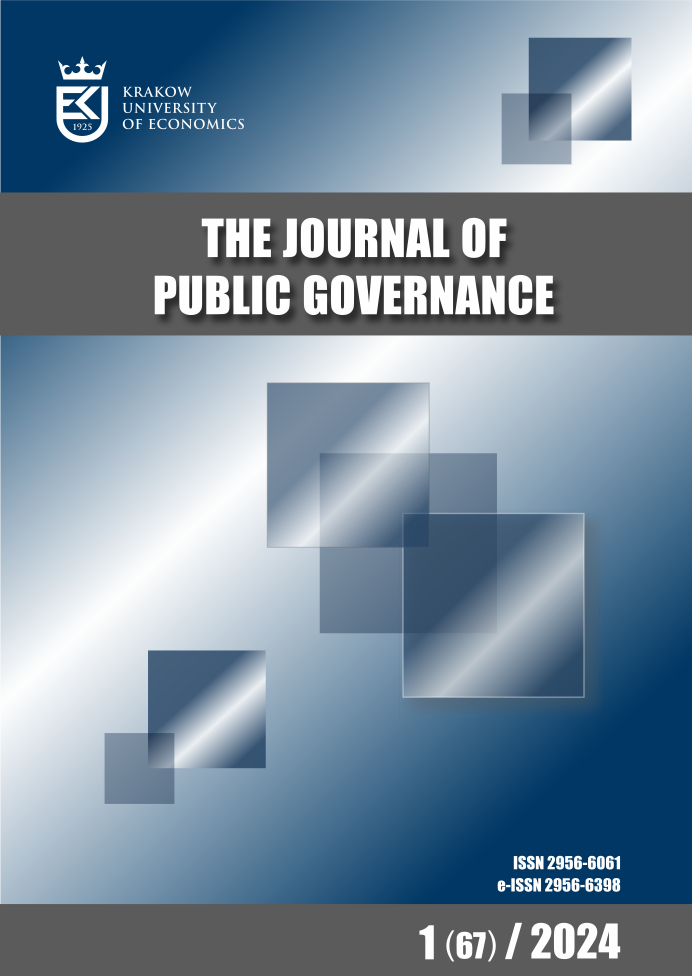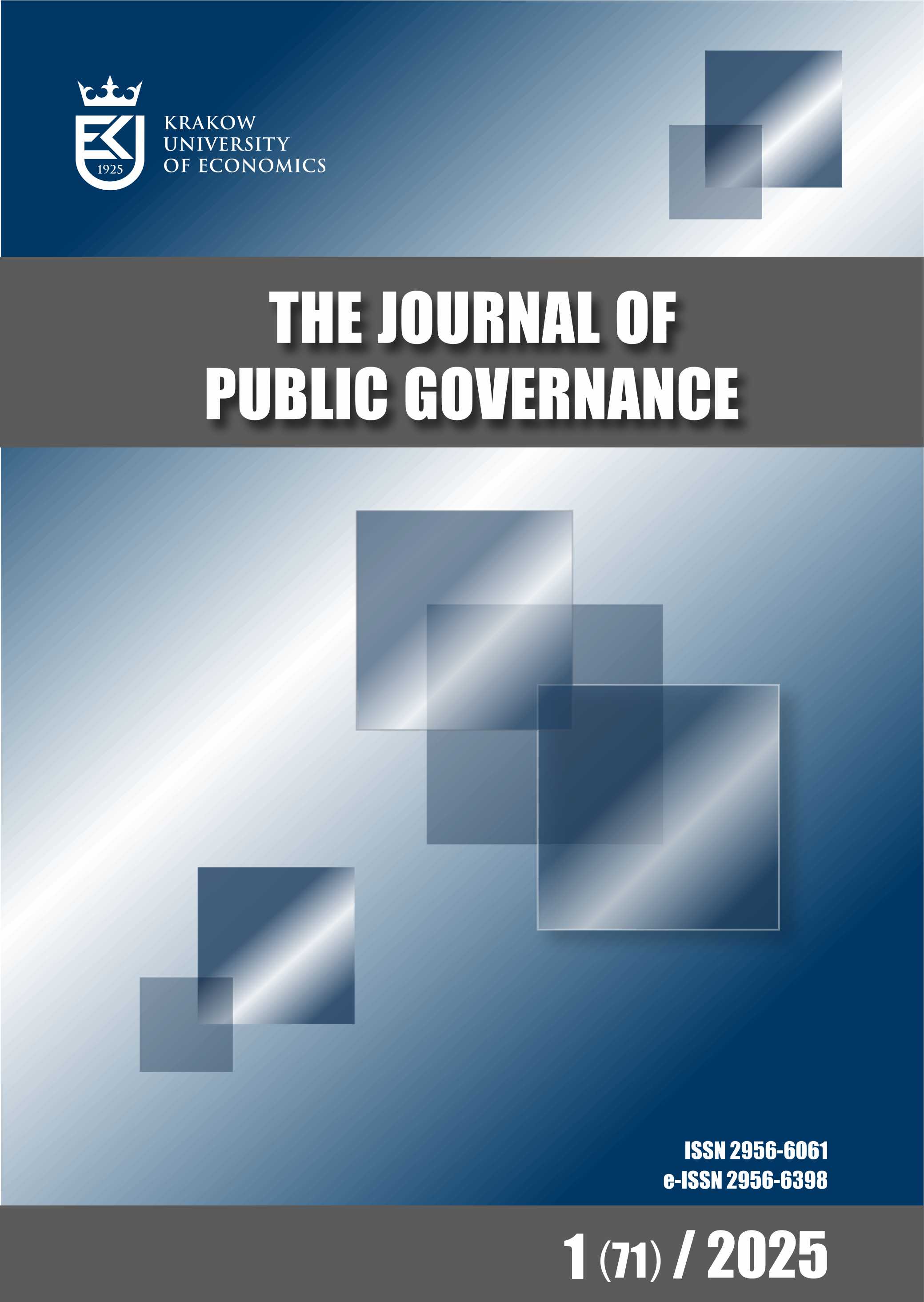The Work-Life Balance of Public Sector Employees in Poland in the Context of Available Legal Regulations
DOI:
https://doi.org/10.15678/PG.2024.67.1.02Keywords:
work–life balance, public sector, public authorities, legal regulationsAbstract
Objective: The purpose of this article is to present changes in the legal system in Poland regarding work-life balance and to confront them with the expectations of public sector employees in this area.
Research Design & Methods: The study is based on the analysis of literature, normative acts, and the results of nationwide surveys conducted in 2021 in Poland based on sample of 3,114 public sector employees.
Findings: Research shows that remote work, the ability to choose working hours, and informal working time arrangements are solutions that would significantly help public sector employees reconcile work and private life.
Implications/Recommendations: The analysis of legal acts shows changes in the approach to the WLB concept over the last decade in Poland and the development of solutions facilitating the reconciliation of professional and personal life. These changes are expected by employees. Difficulties related to the implementation of WLB tools in public organisations are identified resulting from their specific structure, procedures, and budget constraints.
Contribution/Value Added: The article is a source of knowledge for theoreticians, practitioners, employers, and public authorities. The presented results can be used when making decisions aimed at optimising the working conditions of public sector employees and adapting them to changing social needs and legal requirements.
Article classification: research article
Downloads
References
Act of June 26, 1974, Labor Code, Journal of Laws 1974 no. 24 item 141.
Act of June 25, 1999 on cash benefits from social insurance in the event of sickness and maternity, Journal of Laws 1999 no. 60 item 636, as amended.
Act of March 12, 2004 on social assistance, Journal of Laws 2004 No. 64 item 593, as amended.
Act of February 4, 2011 on the care of children under 3 years of age, Journal of Laws 2011 No. 45 item 235, as amended.
Act of February 11, 2016 on state aid in raising children, Journal of Laws 2016 item 195, as amended.
Afifah, L. N., & Satrya, A. (2022). Work–life balance in the public sector: The effect of work from home and work engagement. In S. Noviaristanti (Ed.), Contemporary Research on Management and Business, Proceedings of the International Seminar of Contemporary Research on Business and Management (ISCRBM 2021), 18th December 2021, Jakarta, Indonesia. Available at: https://www.taylorfrancis.com [accessed: 21.04.2024].
Björk-Fant, J. M., Bolander, P., & Forsman, A. K. (2023). Work–life balance and work engagement across the European workforce: a comparative analysis of welfare states. European Journal of Public Health, 33(3), 430–434. https://doi.org/10.1093/eurpub/ckad046
Bailyn, L. (1993). Breaking the mold: Women, men, and time in the new corporate world. Free Press.
Bird, J. (2006). Work-life balance: doing it right and avoiding the pitfalls. Employment Relations Today, 33(3), 21–30. DOI: 10.1002/ert.20114
Blanchard-Fields, F., Chen, Y., & Hebert, C. E. (1997). Interrole Conflict as a Function of Life Stage, Gender, and Gender-Related Personality Attributes. Sex Roles, 37, 155–174. DOI: https://doi.org/10.1023/A:1025691626240
Bond, J. T., Galinsky, E., & Swanberg, J. E. (1997). The National Study of the Changing Workforce. Reports – Research, Families and Work Institute.
Bulger, C. (2014). Work-Life Balance. In A. C. Michalos (Ed.), Encyclopedia of Quality of Life and Well-Being Research. Springer.
Clark, S. C. (2000). Work/family border theory: A new theory of work/family balance. Human Relations, 53(6), 747–770. https://doi.org/10.1177/0018726700536001
den Dulk, L., & Groeneveld, S. (2013). Work–Life Balance Support in the Public Sector in Europe. Review of Public Personnel Administration, 33(4), 384–405. https://doi.org/10.1177/0734371X12449024 Directive (EU) 2019/1158 of the European Parliament and of the Council of 20 June 2019 on work-life balance for parents and carers and repealing Council Directive 2010/18/EU.
Draft regulation of the Prime Minister on the rules for determining the weekly working time schedule and its duration on individual days of the week by heads of certain offices, (2024). project no. 15, https://www.gov.pl/, access: 08/04/2024.
Frone, M. R., Russell, M., & Cooper, M. L. (1992). Antecedents and outcomes of work-family conflict: Testing a model of the work-family interface. Journal of Applied Psychology, 77(1), 65–78. https://doi.org/10.1037/0021-9010.77.1.65
Greenhaus, J. H., & Allen, T. D. (2011). Work–family balance: A review and extension of the literature. In J. C. Quick & L. E. Tetrick (Eds.), Handbook of occupational health psychology (2nd ed.) (pp. 165–183). American Psychological Association.
Greenhaus, J. H., & Beutell, N. J. (1985). Sources of conflict between work and family roles. Academy of Management Review, 10(1), 76–88.
Greenhaus, J. H., Collins, M. K, & Shaw, D. J, (2003). The relationship between work-family balance and quality of life. Journal of Vocational Behavior, 63, 510–531.
Greenhaus, J. H., & Kossek, E. E. (2014), The contemporary career: A work–home perspective. Annual Review of Organizational Psychology and Organizational Behavior, 1(1), 361–388. DOI: 10.1146/annurev-orgpsych-031413-091324
Hammer, L. B., Allen, E., & Grigsby, T. D. (1997). Work–family conflict in dual-earner couples: Within individual and crossover effects of work and family. Journal of Vocational Behavior, 50(2), 185–203. https://doi.org/10.1006/jvbe.1996.1557
Kossek, E. E., & Lautsch, B. A. (2017). Work–Life Flexibility for Whom? Occupational Status and Work–Life Inequality in Upper, Middle, and Lower Level Jobs. Academy of Management Annals, 12(1).
Kossek, E. E., & Ozeki, C. (1998). Work–family conflict, policies, and the job–life satisfaction relationship: A review and directions for organizational behavior – human resources research. Journal of Applied Psychology, 83(2), 139–149. https://doi.org/10.1037/0021-9010.83.2.139
MRPIPS (2024). Remote work, Ministry of Family, Labor and Social Policy, available at: https://www.gov.pl/web/rodzina/praca-zdalna [accessed: 09.04.2024].
Oktosatrio, S., & Liu, J. (2019). A Literature Review of Work-life Balance in the Public Sector, BAM2019 Conference Proceedings, available at: www.bam.ac.uk [accessed: 21.04.2024].
Oskarsson, E., Österberg, J., & Nilsson, J. (2020). Work-life balance among newly employed officers – a qualitative study. Health Psychology Report, 9(1), 39–48. doi: 10.5114/hpr.2020.101250
Parasuraman, S., & Greenhaus, J. H. (2002). Toward reducing some critical gaps in work–family research. Human Resource Management Review, 12(3), 299–312.
Powell, G. N., Greenhaus, J. H., Allen, T. D., & Johnson, R. E. (2019). Introduction to special topic forum: advancing and expanding work-life theory from multiple perspectives. Academy of Management Review, 44(1), 54–71. DOI: 10.5465/amr.2018.0310
Putri, N. K., Melania, M. K. N., Fatmawati, S. M. Y., & Lim Y. Ch. (2023). How does the work-life balance impact stress on primary healthcare workers during the COVID-19 pandemic? BMC Health Services Research, 23, 730. https://doi.org/10.1186/s12913-023-09677-0
Randstad (2024). Workmonitor: The voice of talent in 2024; Rethinking ambition. Randstad, available at: https://www.randstad.com/workmonitor/ [accessed: 08.04.2024].
Resolution No. 80 of the Council of Ministers of May 30 (2018) on the establishment of the government program „Dobry start” (MP, item 514).
Sandhya, D. S. (2024). A conceptual framework for the work–life balance of police officers: a post-COVID-19 perspective. Cogent Business & Management, 11(1). https://doi.org/10.1080/23311975.2024.2304429
Szczudlińska-Kanoś, A., & Marzec, M. (2022). Work Life Balance Instruments in Poland. Theory and practice. Monographs and Studies of the Institute of Public Affairs of the Jagiellonian University, available at: https://isp.uj.edu.pl/nauka/publikacje/monografie-elektroniczne [accessed:16.04.2024].
Thilagavathy, S., & Geetha, S. N. (2023). Work-life balance: A systematic review. Vilakshan – XIMB Journal of Management, 20(2), 258–276. https://doi.org/10.1108/XJM-10-2020-0186
Downloads
Published
Issue
Section
License
Copyright (c) 2024 Krakow University of Economics

This work is licensed under a Creative Commons Attribution 4.0 International License.



